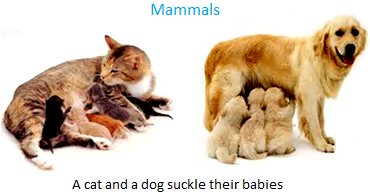Animals that give Birth to Babies
Humans, lions, tigers, cows or bears are the animals give birth to babies. The babies are formed inside the body of the mother. They stay inside for several weeks and are then born. When the babies are born they are weak and helpless. Their mothers care for them and protect them till they learn to look after themselves. They feed their babies with their own milk. These animals are known as mammals.
Animals that give birth to babies are called mammals. So, the
animals, reproducing the babies of their own kind, by directly giving birth, are
called mammals.
For example, human beings are mammals. Cats, dogs, cows, horses, elephants, goats, pigs, lions, rats, squirrel etc. are also mammals.
Accordingly, we know the female mammals give birth to their
young ones. A young one takes shape inside the womb of its mother who finally
gives birth to a developed baby. She also suckles her baby through its infant
stage.
What are the common features of the mammals?
The common features of the mammals are as follows:
(i) Female mammals conceive to give birth.
(ii) They give birth to young ones of their own kind.
(iii) The female mammals have breasts on their bodies. They feed their young ones with their own milk through the breasts.
(iv) They have hair on their bodies.
(v) The temperature of the body of a mammal remains nearly constant. They have
warm blood.
Note: Pygmy is the smallest mammal, 3.5 cm in length and 2 gm of weight.
From Animals that give Birth to Babies to HOME PAGE
Recent Articles
-
What Is Plasma? | Blood Plasma | Proteins | Nutrients | Cholesterol
Nov 07, 25 10:29 AM
Blood is a mobile fluid which is a connective tissue and is derived from the mesoderm like cell any other connective tissue. Colour of blood is reddish and that flows inside the blood vessels by means… -
Disorders of Respiratory System | Tuberculosis | Pleurisy | Emphysema
Oct 28, 25 11:39 PM
Tuberculosis is very common disease and is caused by a type of bacteria called Mycobacterium tuberculosis. This disease causes different trouble in the respiration and infection of several parts of th… -
Regulation of Respiration | Respiratory Centres | Inspiratory Area |
Oct 14, 25 12:13 AM
Respiratory Centre is the area that controls the rate of respiration and it is observed to be located in medulla oblongata and pons. Respiratory Centre has the following will dispersed components like… -
Explain Transport of Gases | External Respiration | Tissue Respiration
Oct 09, 25 11:35 PM
In humans gaseous exchange is completed in the following ways the steps are - External Respiration or Breathing - Breathing in false taking in of Oxygen and giving out of carbon dioxide in the body. M… -
Kind and Number of Teeth | Location of Teeth in Mouth | Care of Teeth
Sep 11, 25 12:52 AM
Kind and Number of Teeth






New! Comments
Have your say about what you just read! Leave me a comment in the box below.